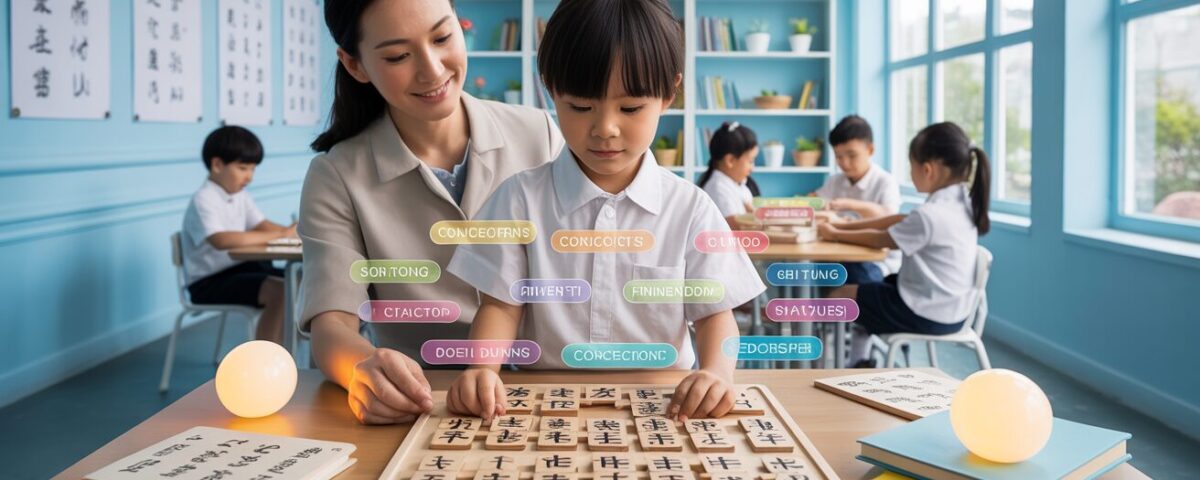
Picture-Description Masterclass: Essential Techniques for PSLE Chinese Oral Success
November 1, 2025
4 Essential Story Structures to Ace PSLE Chinese Narrative Writing
November 4, 2025Table Of Contents
- Introduction: The Power of Chinese Connectors
- What Are Chinese Connectors and Why They Matter
- Sequential Connectors (顺序连接词)
- Causal Connectors (因果连接词)
- Transitional Connectors (转折连接词)
- Conditional Connectors (条件连接词)
- Progressive Connectors (递进连接词)
- Supplementary Connectors (补充连接词)
- How to Select the Right Connectors for Your Composition
- Common Mistakes to Avoid When Using Connectors
- Effective Practice Techniques for Mastering Connectors
- Conclusion: Building Confidence Through Connector Mastery
Imagine transforming a simple Chinese composition into a flowing masterpiece that captivates readers and impresses examiners. The secret lies not just in vocabulary or grammar, but in the artful use of Chinese connectors – those powerful linguistic bridges that elevate writing from disjointed sentences to cohesive, sophisticated expression.
At Seashell Academy by Suntown Education Centre, we’ve seen countless Primary 1-6 students make remarkable improvements in their Chinese composition scores by mastering these essential language tools. Like the protective seashell that nurtures a pearl’s development, these connectors provide the structure that allows young writers’ ideas to shine brilliantly.
In this comprehensive guide, we’ll explore 30 high-impact Chinese connectors organized by function, providing clear explanations, practical examples, and application strategies aligned with primary school examination requirements. Whether your child struggles with basic sentence linking or needs to refine their advanced writing skills, these connectors will serve as invaluable tools in their Chinese language journey.
What Are Chinese Connectors and Why They Matter
Chinese connectors (连接词) are words or phrases that link sentences, paragraphs, and ideas together. They act as bridges between thoughts, guiding readers smoothly from one concept to the next. For primary school students, mastering these connectors is critical for several reasons:
First, connectors transform simple writing into more sophisticated expression. Instead of using basic sentences like “I was tired. I went to sleep,” connectors allow students to write “因为我很累,所以我去睡觉了” (Because I was tired, I went to sleep).
Second, connectors demonstrate a higher level of language proficiency to examiners. Primary School Leaving Examination (PSLE) markers specifically look for varied connector usage as evidence of advanced writing ability.
Third, connectors enhance the logical flow of compositions, making arguments and narratives more compelling and easier to follow. This clarity of expression is essential for effective communication in any language.
According to our teaching experience at Seashell Academy, students who effectively use varied connectors typically score 15-20% higher on composition exercises than those who rely on simple sentence structures. Let’s explore these powerful tools that can transform your child’s Chinese writing.
Sequential Connectors (顺序连接词)
Sequential connectors help establish chronological order or step-by-step progression in a composition. They are essential for narrative writing and procedural descriptions, creating a clear timeline of events.
1. 首先 (Shǒu xiān) – First/Firstly
Used to introduce the first point in a sequence or the beginning of a process.
Example: 首先,我们需要准备所有的材料。(First, we need to prepare all the materials.)
2. 其次 (Qí cì) – Second/Secondly
Follows ‘首先’ to introduce the second point or step in a sequence.
Example: 其次,我们要仔细阅读说明书。(Second, we need to carefully read the instructions.)
3. 然后 (Rán hòu) – Then/Afterward
Indicates the next step or event in a sequence, useful for connecting actions in a story.
Example: 我们吃完午餐,然后去公园散步。(We finished lunch, then went to the park for a walk.)
4. 接着 (Jiē zhe) – Following this/Next
Similar to ‘然后’ but emphasizes continuity between actions or events.
Example: 他敲了敲门,接着走进了房间。(He knocked on the door, then entered the room.)
5. 最后 (Zuì hòu) – Finally/Lastly
Signals the final point in a sequence or the conclusion of a process.
Example: 最后,我们要检查所有的答案。(Finally, we need to check all the answers.)
In our P4 Chinese Programme, we emphasize these sequential connectors as fundamental building blocks for narrative compositions. Students learn to create a clear timeline using these connectors before advancing to more complex expressions.
Causal Connectors (因果连接词)
Causal connectors establish relationships of cause and effect, explaining why things happen and their consequences. These connectors are crucial for argumentative writing and logical reasoning in compositions.
6. 因为…所以… (Yīn wèi…suǒ yǐ…) – Because…therefore…
This paired connector links a cause with its effect, forming a complete logical statement.
Example: 因为下雨了,所以我们取消了野餐。(Because it was raining, therefore we canceled the picnic.)
7. 由于 (Yóu yú) – Due to/Owing to
A more formal alternative to ‘因为’ that works well in academic writing.
Example: 由于交通堵塞,我迟到了。(Due to traffic congestion, I was late.)
8. 因此 (Yīn cǐ) – Thus/Hence
Introduces a result or consequence with a slightly more formal tone than ‘所以’.
Example: 他没有复习,因此考试没通过。(He didn’t review, thus he failed the exam.)
9. 结果 (Jié guǒ) – As a result
Emphasizes the outcome of an action or situation, often with unexpected or significant consequences.
Example: 他没听医生的建议,结果病情加重了。(He didn’t follow the doctor’s advice, as a result, his condition worsened.)
10. 为了 (Wèi le) – In order to/For the purpose of
Explains the purpose or intention behind an action.
Example: 为了考上好大学,他每天努力学习。(In order to get into a good university, he studies hard every day.)
Students in our P5 Chinese Programme practice these causal connectors extensively through structured exercises that develop critical thinking alongside language skills. The ability to express cause-effect relationships clearly distinguishes exceptional compositions from average ones.
Transitional Connectors (转折连接词)
Transitional connectors introduce contrast or unexpected changes in direction, adding depth and complexity to compositions. These connectors create tension and interest in narratives and demonstrate sophisticated reasoning in argumentative writing.
11. 但是 (Dàn shì) – But/However
The most common transitional connector, used to present a contrasting idea or exception.
Example: 这道题很难,但是他还是解出来了。(This question was difficult, but he still solved it.)
12. 虽然…但是… (Suī rán…dàn shì…) – Although…but…
This paired connector creates a concession-contrast structure, acknowledging one fact while presenting a contrasting point.
Example: 虽然他很累,但是他坚持完成了工作。(Although he was tired, he persisted in completing the work.)
13. 然而 (Rán ér) – However/Nevertheless
A slightly more formal alternative to ‘但是’ that signals a significant contrast.
Example: 我们做了充分的准备,然而比赛还是输了。(We made adequate preparations, however, we still lost the match.)
14. 相反 (Xiāng fǎn) – On the contrary/Conversely
Introduces an idea that is directly opposite to what was previously stated.
Example: 他不是懒惰的人,相反,他非常勤奋。(He is not a lazy person; on the contrary, he is very diligent.)
15. 尽管如此 (Jǐn guǎn rú cǐ) – Despite this/Nevertheless
Acknowledges a challenge or obstacle while emphasizing continuation or perseverance.
Example: 道路结冰很危险,尽管如此,他们还是决定出发。(The icy road was dangerous; nevertheless, they decided to set out.)
At Seashell Academy, our P6 Chinese Programme emphasizes these transitional connectors as crucial tools for creating sophisticated compositions that showcase critical thinking and nuanced perspectives – essential skills for PSLE success.
Conditional Connectors (条件连接词)
Conditional connectors establish relationships where one circumstance depends on another. They are essential for expressing hypothetical scenarios, making predictions, and explaining dependencies.
16. 如果…就… (Rú guǒ…jiù…) – If…then…
This paired connector creates a clear condition-result relationship.
Example: 如果明天下雨,我们就在室内活动。(If it rains tomorrow, then we’ll have indoor activities.)
17. 除非 (Chú fēi) – Unless
Establishes an exception as the only condition under which something will happen.
Example: 除非你道歉,否则我不会原谅你。(Unless you apologize, I won’t forgive you.)
18. 只要 (Zhǐ yào) – As long as/Provided that
Indicates a sufficient condition for something to happen.
Example: 只要你努力学习,就一定能进步。(As long as you study hard, you will certainly improve.)
19. 假如 (Jiǎ rú) – If/Supposing
Similar to ‘如果’ but often used for more hypothetical or imaginary scenarios.
Example: 假如我是一只鸟,我会飞到世界各地。(If I were a bird, I would fly all over the world.)
20. 无论 (Wú lùn) – No matter what/Regardless of
Indicates that a result will remain the same despite varying conditions.
Example: 无论发生什么,我都会支持你。(No matter what happens, I will support you.)
In our classrooms, we incorporate these conditional connectors into scenario-based writing exercises. This approach, part of our unique Seashell Method, helps students develop both linguistic skills and critical thinking abilities simultaneously.
Progressive Connectors (递进连接词)
Progressive connectors build intensity or add stronger points to an argument or description. They help create a sense of escalation or advancement in writing, making compositions more dynamic and persuasive.
21. 不仅…而且… (Bù jǐn…ér qiě…) – Not only…but also…
This paired connector adds a second point that builds upon or exceeds the first point.
Example: 这本书不仅有趣,而且很有教育意义。(This book is not only interesting but also educational.)
22. 甚至 (Shèn zhì) – Even/To the extent that
Introduces a more extreme case or example that emphasizes the intensity of a situation.
Example: 他非常喜欢阅读,甚至晚上睡觉前也要看书。(He loves reading very much, even before going to bed at night he must read.)
23. 更 (Gèng) – Even more/Furthermore
Adds a stronger point or indicates a greater degree of something.
Example: 这个问题很复杂,更需要仔细思考。(This problem is complex and furthermore requires careful thinking.)
24. 况且 (Kuàng qiě) – Moreover/Besides
Adds a supplementary reason or argument that strengthens the previous point.
Example: 我不想去那个派对,况且我明天还有考试。(I don’t want to go to that party, moreover, I have an exam tomorrow.)
25. 何况 (Hé kuàng) – Not to mention/Let alone
Introduces a stronger reason or more extreme case after establishing a basic point.
Example: 简单的问题他都不会,何况这么复杂的题目。(He can’t even solve simple problems, let alone such complex questions.)
Supplementary Connectors (补充连接词)
Supplementary connectors add information, examples, or clarifications to support main points. They help make writing more detailed, clear, and persuasive by providing evidence or elaboration.
26. 例如 (Lì rú) – For example/Such as
Introduces specific examples to illustrate a general point.
Example: 有许多方法可以保持健康,例如均衡饮食和规律运动。(There are many ways to stay healthy, for example, balanced diet and regular exercise.)
27. 换句话说 (Huàn jù huà shuō) – In other words
Restates an idea in different words for clarity or emphasis.
Example: 这个任务需要团队合作,换句话说,我们必须一起努力。(This task requires teamwork; in other words, we must work together.)
28. 也就是说 (Yě jiù shì shuō) – That is to say
Provides an explanation or clarification of a previous statement.
Example: 我们要提前一小时到达,也就是说我们应该九点出发。(We need to arrive one hour early, that is to say, we should leave at nine o’clock.)
29. 除此之外 (Chú cǐ zhī wài) – Besides this/In addition
Adds supplementary information beyond what has already been mentioned.
Example: 这家餐厅的食物很美味,除此之外,服务也很好。(The food at this restaurant is delicious; besides this, the service is also good.)
30. 总而言之 (Zǒng ér yán zhī) – In conclusion/Overall
Summarizes or concludes a series of points or an entire argument.
Example: 总而言之,我们需要更多地关注环境保护。(In conclusion, we need to pay more attention to environmental protection.)
How to Select the Right Connectors for Your Composition
Choosing appropriate connectors can significantly enhance the quality of Chinese compositions. At Seashell Academy by Suntown Education Centre, we teach students a systematic approach to connector selection based on our Seashell Method:
Identify the relationship: First, determine what relationship you need to establish between ideas. Is it sequential, causal, transitional, conditional, progressive, or supplementary?
Consider the tone and formality: Some connectors are more appropriate for formal writing (如 ‘因此’, ‘然而’), while others work better in casual contexts (如 ‘所以’, ‘但是’).
Avoid repetition: Use a variety of connectors rather than repeating the same ones. For example, alternate between ‘但是’, ‘然而’, and ‘不过’ for contrasting ideas.
Match grade-level expectations: Primary 3-4 students should master basic connectors like ‘因为…所以…’ and ‘但是’, while Primary 5-6 students should incorporate more sophisticated options like ‘尽管如此’ and ‘不仅…而且…’.
Consider the flow: Choose connectors that create a natural rhythm in your writing. Sometimes a simpler connector maintains better flow than a complex one that disrupts reading.
Our teachers at Seashell Academy use mind-mapping techniques to help students visualize these connector relationships, making it easier to select the perfect connector for each writing situation.
Common Mistakes to Avoid When Using Connectors
Even with a strong grasp of Chinese connectors, students often make several common errors that can undermine their compositions. Here are key mistakes to watch for:
Mismatched paired connectors: When using paired connectors like ‘因为…所以…’ or ‘虽然…但是…’, both parts must be included and correctly ordered. A common error is writing ‘因为我很累所以我去睡觉了’ as one continuous clause without proper punctuation. The correct form requires a comma: ‘因为我很累,所以我去睡觉了’.
Connector overuse: Using too many connectors can make writing feel mechanical and disjointed. Focus on quality over quantity, using connectors only when they truly enhance the logical flow.
Inappropriate formality level: Using highly formal connectors in a casual narrative or basic connectors in a formal argumentative essay creates tonal inconsistency. Match connector formality to your composition type.
Redundant connectors: Avoid using multiple connectors that serve the same function together, such as ‘所以因此’ or ‘但是然而’. Choose the one that best fits your meaning.
Incorrect logical relationships: Make sure the connector accurately represents the relationship between ideas. For example, using ‘所以’ (therefore) when there is no causal relationship creates logical confusion.
At Seashell Academy, our experienced MOE-trained educators provide targeted feedback on these common errors, helping students refine their connector usage for maximum impact in compositions.
Effective Practice Techniques for Mastering Connectors
Consistent, structured practice is essential for mastering Chinese connectors. Here are proven techniques we employ at Seashell Academy that parents can also use at home:
Sentence combination exercises: Take two simple sentences and practice combining them using different connectors. For example, “我喜欢游泳” and “我不会游泳” could become “虽然我不会游泳,但是我喜欢游泳。”
Connector substitution: Take a paragraph and replace basic connectors with more sophisticated alternatives, noting how the meaning and tone change.
Gap-fill activities: Remove connectors from a well-written passage and challenge your child to fill in appropriate connectors that maintain the logical flow.
Connector categories game: Create cards with different connectors and have your child sort them into functional categories (sequential, causal, etc.), then create sentences using each.
Real-life application: Encourage your child to identify connectors in Chinese storybooks, newspapers, or even television subtitles, discussing how these connectors enhance meaning.
Our gamified interactive lessons at Seashell Academy make these practice techniques engaging rather than tedious. We find that students who practice connectors through enjoyable activities develop both better retention and more natural application in their writing.
Conclusion: Building Confidence Through Connector Mastery
Mastering Chinese connectors is not merely an academic exercise—it’s a transformative skill that empowers students to express themselves with clarity, sophistication, and confidence. These 30 high-impact connectors serve as essential tools that can elevate primary school compositions from basic to brilliant.
At Seashell Academy by Suntown Education Centre, we’ve witnessed countless students experience breakthrough moments when connector mastery suddenly makes their writing flow naturally. Like a pearl developing within a protective seashell, your child’s Chinese language abilities can grow and shine with the right structure and nurturing environment.
Remember that connector mastery develops gradually through consistent practice, meaningful application, and supportive guidance. Rather than overwhelming your child with all 30 connectors at once, focus on mastering a few from each category before expanding their repertoire.
As your child incorporates these connectors into their writing toolkit, they’ll develop not just better compositions, but greater confidence in their Chinese language abilities overall—a confidence that extends far beyond examinations into a genuine appreciation for the beauty and power of effective communication.
Ready to transform your child’s Chinese composition skills?
At Seashell Academy by Suntown Education Centre, our experienced MOE-trained educators specialize in nurturing primary school students’ Chinese language abilities through our unique Seashell Method. Our small class sizes ensure personalized attention, while our structured learning plans make mastering connectors and other essential skills both effective and enjoyable.
Contact Us Today to learn how we can help your child develop stronger Chinese composition skills and a genuine love for the language!





